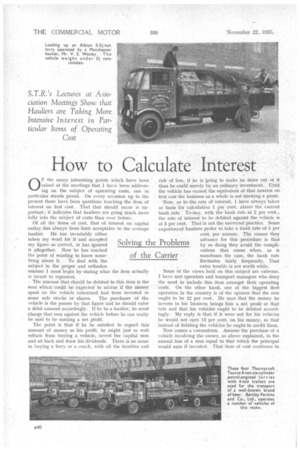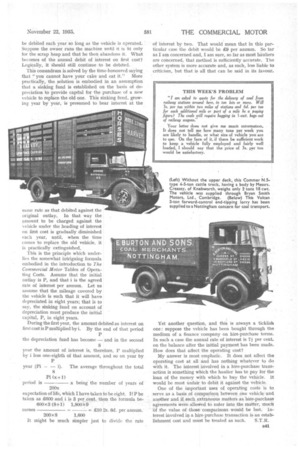How to Calculate Interest
Page 50

Page 51

If you've noticed an error in this article please click here to report it so we can fix it.
0 F the many interesting points which have been raised at the meetings that I have been addressing on the subject of operating costs, one in particular stands proud. On every occasion up to the present there have been questions touching the item of interest on first cost. That that should occur is important; it indicates that hauliers are going much more fully into the subject of costs than ever before.
Of all the items of cost, that of interest on capital outlay, lidsalways been %lest acceptable to the average haulier. He has invariably either taken my word for it and accepted my figure as correct, or has ignored it altogether. Now he has reached the point of wanting to, know some
thing about it. To deal with the .subject in the proper and orthodox . manner I must begin by stating what the item actually
is .meant •tO represent. ,
. The amount that should be debited to this item is the sum whicn could be .expected to accrue if the money spent on the vehicle concerned had been invested in some safe stocks or shares. The purchaser Of the vehicle is the poorer by that figure and he should enter a debit amount accordingly. If he be a haulier, he must charge that sum against the vehicle before he can really be said to be earning a net profit.
The point is that if he be satisfied to regard this amount of money as his profit, he might just as well refrain from buying a vehicle, invest the capital sum and sit back and draw his dividends. There is no sense in buying a lorry or a coach, with all the troubles and
Solving th of the
risk of loss, if he is 'going to make no more out of it than he could merely by an ordinary investment. -Until the vehicle has earned the equivalent of that interest on first cost the business as a whole is not showing a profit.
'Now, as to-the rate of interest, I have always taken as basis for calculation 1 per cent. above the current bank rate. To-day, with the bank rate at 2 per cent., the rate of interest to be debited against the vehicle is at 3 per cent. That is not the uniVersal practice. Some experienced hauliers prefer to take a fixed rate of 5 per cent. per annum. The reason they advance for this procedure is that by so doing they avoid the complications that ensue when, as is sometimes the case, the bank rate fluctuates fairly. frequently. That
e Problems Carrier
extra trouble is not worth while.
Some Of the views held on this subject are extreme. I have met operators and transport managers who deny the need to include this item amongst their operating costs. On the other hand, one of the biggest fleet operators in the country is of the opinion that the rate ought to be 12 per cent. He says that the money he invests in his business brings him a net profit at that rate and that his vehicles ought to be debited accordingly. My reply is that if it were not for his vehicles he would not earn 12 per cent. on his money, so that instead of debiting the vehicles he ought to credit them.
Now comes a conundrum. Assume the purchase of a vehicle involving the owner, as above explained, in the annual loss of a sum equal to that which the principal would earn if invested. That item of cost continues to be debited each year so long as the vehicle is operated. Suppose the owner runs the machine until it is fit only for the scrap heap and that he then abandons it. What becomes of the annual debit of interest on first cost? Logically, it Should still continue to be debited.
This conundrum is salved by the time-honoured saying that 'you cannot have your cake and eat it." More practically, the solution is embodied in an assumption that a sinking, fund is established on the basis of depreciation to provide capital for the 'purchase of a new vehicle to replace the old one. This sinking fund, growing year by year, is presumed to bear interest at the
same rate as that debited against the original outlay. In that way the amount to be charged against the vehicle under the heading of interest on first cost is gradually diminished each year, until, when the time comes to replace the old vehicle, it is practically extinguished.
This is the principle which underlies the somewhat intriguing formula embodied in the introduction to The Commercial Motor Tables of Operating Costs. Assume that the initial outlay is P. and that i is the agreed rate of interest per annum. Let as assume that the mileage covered by the vehicle is such that it will have depreciated in eight years; that is to say, the sinking fund on account of depreciation must produce the initial capital, P, in eight years. of interest by two. That would mean that in this particular case tho debit would be £9 per annum. So tar as I am concerned and, I am sure, so far as most hiuliers are concerned, that method is sufficiently accurate. The other system is more accurate and, as such, less liable to criticism, but that is all that can be said in its favour.
Yet another question, and this is always a ticklish one : suppose the vehicle has been bought through the medium of a finance company on hire-purchase terms. In such a case the annual rate of interest is 7 per cent. on the balance after the initial payment has been made. How does that affect the operating cost?
My answer is most emphatic. It does not affect the operating cost at all and has nothing whatever to do with it. The interest involved in a hire-purchase transaction is something which the haulier has to pay for the loan of the money with which to buy the vehicle, It would be most Unfair to debit it against the vehicle.
One of the important uses of operating costs is to serve as a basis of comparison between One vehicle and another and if such extraneous matters s, hire-purchase agreements were allowed to enter into the matter, mach "of the value of those comparisons would be Iest interest involved in a hire-purchase transaction is an estab lishment cost and must he treated as such. S.T.R.




















































































